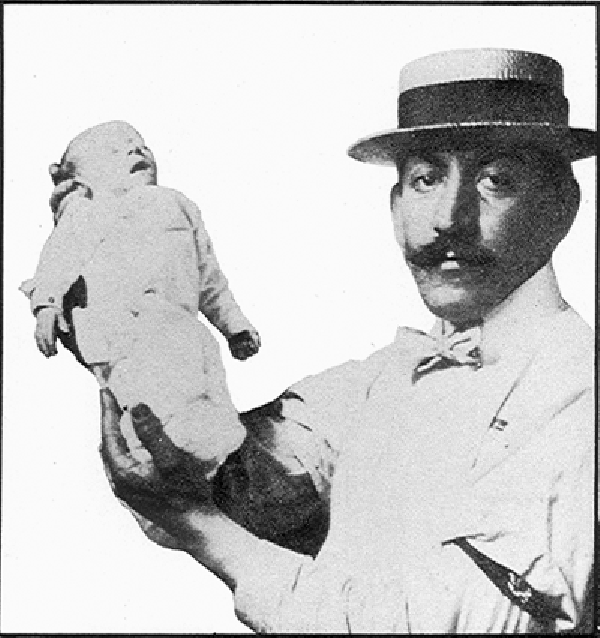
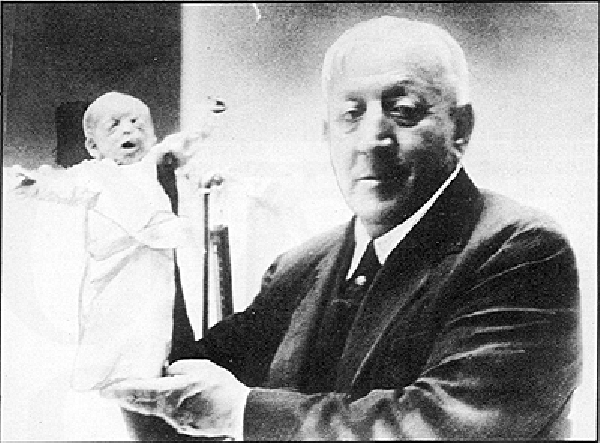

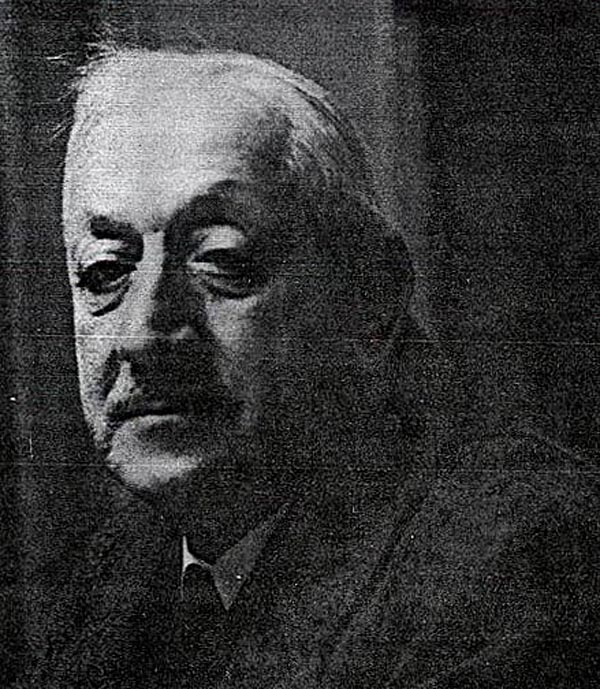
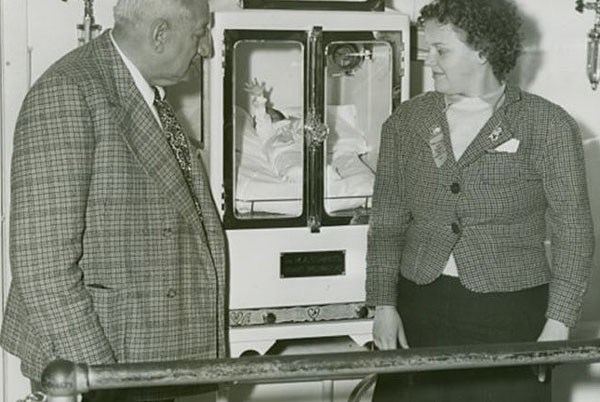
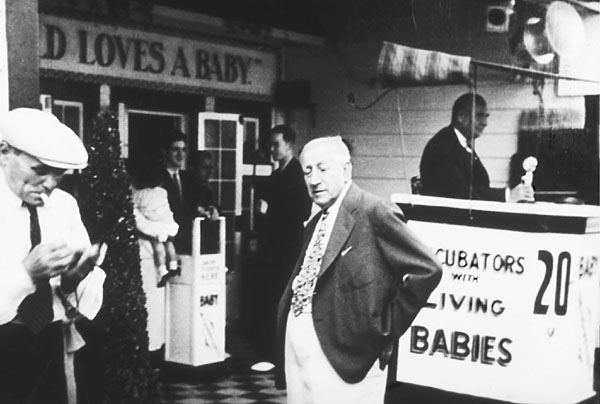
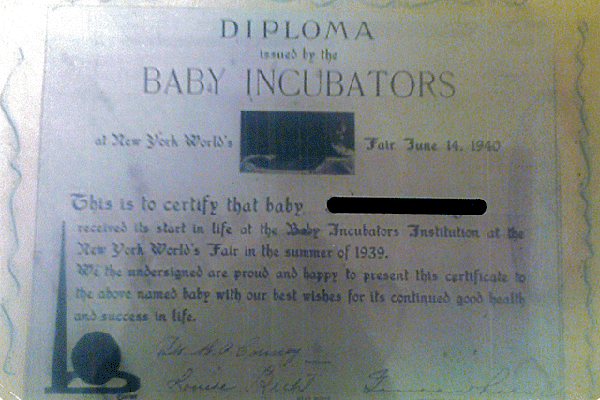
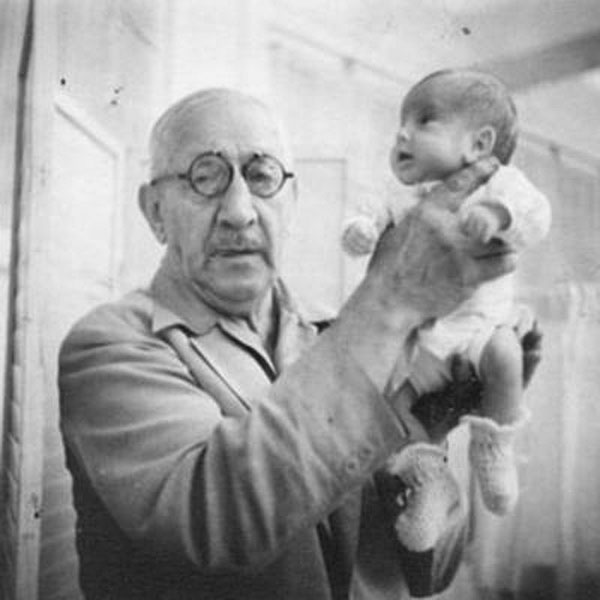
A controversial figure in the history of neonatology, Dr. Martin Couney made a career of exhibiting and caring for premature infants at world fairs, expositions, and amusement parks from 1896 until the 1940's. He claimed to have trained with Pierre Budin, have taught Julius Hess how to take care of premies, and to have invented the incubators used in his exhibits (they were actually Lion Incubators manufactured under license. Many of the popular press articles about him, some of whicih are linked below, propagated this legend that he built for himself. It's true that he was friends with Julius Hess, as attested by the letter below, but he remained outside the mainstream of newborn medicine until his death.
Interest in these "incubator baby" sideshows and exhibitions, which had faded from memory as neonatology training and neonatal intensive care units were established in the 1960s and '70s, was revived by Dr. William Silverman's 1979 article "Incubator-Baby Side Shows" and its follow-up articles in Pediatrics. Since then, others continued to research Couney and understand the extent of his ventures.
More recently, the book "The Strange Case of Dr. Couney: How a Mysterious European Saved Thousands of American Babies" by Dawn Raffel has brought many details of Martin Couney's origins to light. Born Michael Cohn in 1869 in the town of Krotoszyn, then part of the Prussian Empire and now in Poland, he left for England to become a carnival showman, and eventually emigrated to the United States, with several name changes along the way. He married Annabelle Maye Segner, of Lafayette, Indiana, in 1903, and they had daughter Hildegarde who grew up to become a nurse and would later manage Couney's exhibits in Atlantic City.
"In 1898, 1 year before the Chicago Lying-In Hospital nursery opened, Couney moved to the United States and had an incubator exhibit at the Trans-Mississippi Exposition in Omaha, Nebraska. The infants for the exhibit allegedly were transported from Chicago to Omaha.
"In 1900 Couney went to Paris to exhibit at the World Exposition, returning to the United States to exhibit at the Buffalo Pan-American Exposition the following year.
"At the Louisiana Purchase Exposition in St. Louis in 1904, Couney had an elaborate two-story building with an inner courtyard. Although it is not certain, the babies were probably exhibited on the first floor, while Couney and the nurses lived on the second floor of the building. [Editor's note: this is an error, the Louisiana Purchase Exhibition incubator building was not managed by Couney.]
"Couney also exhibited at the Panama Pacific International Exposition in 1915 in San Francisco, California. These were elaborate exhibitions, costing a great deal of money to build, considering that they were used for only 1 or 2 years at the most.
"Couney exhibited outside the United States at other world fairs too, including those held in South America and South Africa. In addition to these transient exhibits, he had several permanent summer exhibits that were much less elaborate than those he created for world fair audiences. His Coney Island New York exhibit, for example, existed with continuous summer operation (June through September) from 1903 until 1943, when public disinterest and World War II forced the show to close. He also had semi-permanent exhibits of the same type at Atlantic City, New Jersey, and for a shorter period of time, probably from 1912 to 1920, in Chicago's White City amusement park."
-- "The Care of Premature Infants: Historical Perspective," by Dr. Lawrence M. Garner and Dr. Carol B. Gartner, Neonatal Intensive Care: A History of Excellence, NIH Publication No. 92-2786, October 1992.
 | Presumed photograph of the young Martin Couney from the Pan-American Exhibition in Buffalo, New York, 1901. |
 | Photograph of Martin Couney from the New York Worlds Fair, 1939. |
 | Couney with parade float advertising his exhibit in Atlantic City. |
 | A photo of the "Incubator-doctor" at the time of the New York World's Fair, 1939-1940. |
 | Another photo of Couney at one of his incubator exhibits, date unknown. |
 | Couney in front of the entrance to one of his incubator exhibits, date unknown. |
 | A "Graduation Diploma" for a premie cared for at the Baby Incubaators Exhibit at the New York World's Fair, 1939-1940, signed by Dr. Martin Couney and his head nurse Louise Recht. |

| Martin Couney in 1941. -- Coney Island History Project |
A letter from Martin Couney to the parents of one of his patients at the "Century of Progress International Exposition" in Chicago, 1933-34.
Continuing research has cast doubt upon much of Couney's background, but there's little question about the number of babies he cared for and the respect he enjoyed from physicians of his day, including the renowned pediatrician Julius Hess. The letter below, from Julius Hess to Martin Couney, was discovered in the visitor's book for Couney's exhibit at the 1939 New York World's Fair.
Couney's obituary appeared in the New York Times, March 2, 1950. We now know that much of his early legend described in the obituary, such as the MD granted in Germany and his training with Budin, was fictitious, and the records of the Berlin Exhibition do not mention him. However, his exhibitions at Omaha and later are well documented and over the years he saved thousands of babies that would have otherwise perished.

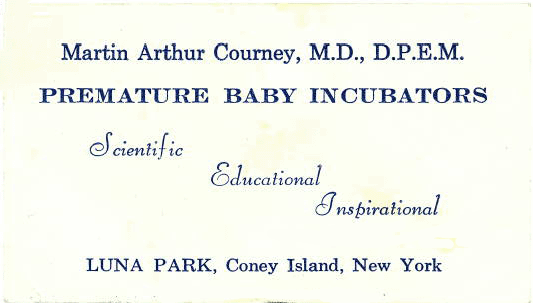
Martin Couney's business card.